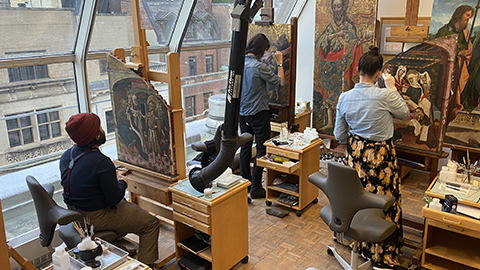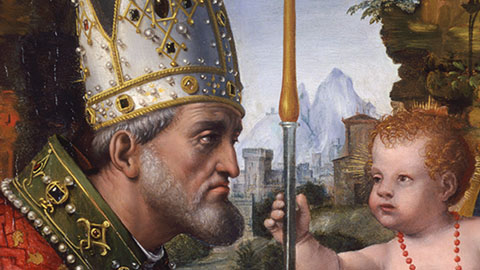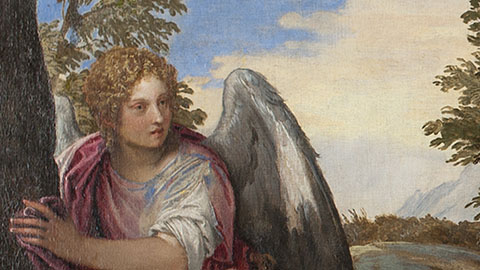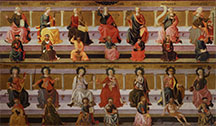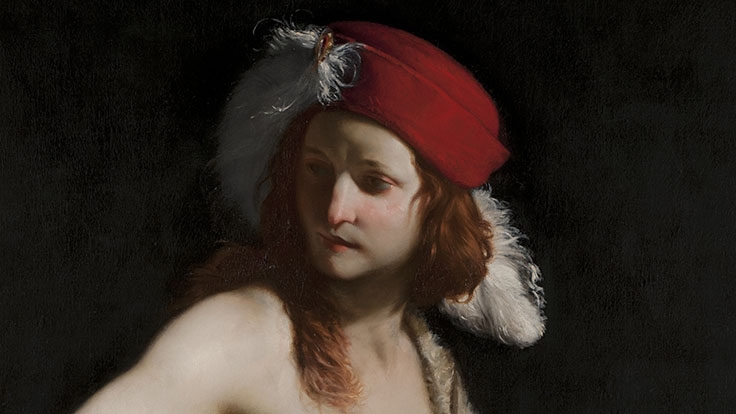Glossary (A-L)
Conservation uses specialized terminology which may be unfamiliar to some. We have created this illustrated glossary defining and discussing some frequently referenced terms and concepts.
A
Abrasion
Damage caused by repeated contact with another material, gradually wearing away the surface. On a painting, abrasion may be identified as small spots revealing an underlayer, which may disrupt the way a passage of paint is read, making it appear thinner or breaking up forms. Harsh cleaning campaigns by strong solvents or aggressive mechanical action in past conservation treatments are common causes of abrasion.
Cleaned state detail showing heavy abrasion in the sky and tree branches.
Vittore Carpaccio, Temperance, c. 1525, High Museum of Art, K25.
Image credit: Shan KuangAlla Prima
Also see (Wet in wet)
Alla Prima, also known as wet in wet, refers to the practice of applying fresh paint over underlayers that are not fully dry. The consistency of the paint must be fairly pastose and contain enough medium so that it does not dry too quickly. Over the initial lay-in, more paint is added, and the layers can be incorporated into one another using a stiff bristle brush, often creating multi-colored swirls of impasto. It requires rapid execution and is prized for its spontaneity.
Photomicrograph of alla prima brushwork in a gondoliere.
Canaletto, The Grand Canal from the Campo San Vio, c.1730-35, Memphis Brooks Museum of Art, K2173.
Image credit: Shan KuangB
Binder
Paint is made up of dry pigment particles mixed with some sort of adhesive substance, which is known as the binder or the medium. Many materials have been used for this purpose. There are water soluble binders, such as various animal glues and gums, used both for ephemeral works and for a type of painting on fine linen known as a tüchlein, used by Justus van Ghent, Dürer, and Mantegna, among others. Egg yolk and beaten egg white, called glair, was used by Early Italian painters for works on wood panel and for illuminating manuscripts. In Northern Europe drying oil was preferred because of its translucence and the facility with which it could be blended to achieve more naturalistic effects. In the mid to late fourteenth, oil paint began to be used in Italy as well and was ubiquitous by the early fifteenth century. The two principal types of drying oil used for painting are linseed oil, which dries faster but becomes slightly yellow with age and walnut oil, slower to dry but with more fluid handling, remains colorless. Various materials could be added to alter the properties of the binder: driers, volatile oils, and resins. Unlike aqueous mediums which dry by evaporation, drying oils polymerize over time into a tough, durable film.
Boiled linseed oil, a binder, and other pigments used for during a reconstruction project.
Image credit: Emma KimmelBole
A material made from mixing colored clay with a water-based adhesive, such as rabbit skin glue. It is used as a preparatory layer on which gold or silver leaf is then applied. Bole is traditionally red, though it can range greatly in color. Giotto used green earth, which contains a bit of clay, for some of his works. The color of the bole affects the final appearance of the thin gold or silver leaf applied on top.
Left: Exposed red bole; Right: After re-gilding and restoration.
Andrea di Bartolo, The Crucifixion, with the Virgin, Mary Magdelene and Saint John the Evangelist, c.1400, Vanderbilt University Fine Arts Gallery, K1014.
Image credit: Soon Kai PohDetail of green bole.
Giotto and assistants, Peruzzi Altarpiece: St. John the Evangelist, c. 1265-1337, North Carolina Museum of Art, K1441.
Burnishing
A water gilding technique which uses a hard stone or material such as agate or an animal’s tooth to polish the surface of the metal leaf.
C
Cartoon
A full-scale drawing or sketch used to transfer a design onto the preparatory layer of a painting. These drawings were made by assembling individual sheets of paper by gluing the overlapped edges to produce a piece large enough to accommodate the image, known as a cartone, or "big paper." After the design was made, its outlines were pricked and fine black powder was dusted through the small holes leaving a series of dots, called spolvero. The design was reinforced with either a dry or aqueous medium and the residue of black powder blown away or lightly dusted off. Sometimes the outlines were gone over with a sharp instrument that impressed them into the surface preparation. But this method tended to damage the cartoon so that it could not be reused and was adopted primarily for frescos.
An alternative technique, usually used to create secondary cartoons or for copying painting, was to take a tracing using a piece of paper or parchment that had been oiled to make it translucent and then apply a layer of black (or sometimes white) pigment to the reverse, impressing the design onto an intermediate piece of paper. Sometimes a translucent cast of fish glue was used instead of oiled paper or parchment.
Cleaning
The process of removing nonoriginal surface coatings or accretions from a painting. In paintings conservation "cleaning" usually refers to the removal of varnish and/or overpaint. Cleaning can involve the use of volatile solvents, various gel formulations, poultices, and mechanical methods.
"Surface cleaning" usually refers to the removal of dirt, soot, smoke, or other residues using either dry or aqueous material, without affecting the varnish.
Left: before cleaning; Right: after the removal of oxidized yellow varnish.
Moretto da Brescia, Saint Jerome Penitent, 1530-40, Howard University Gallery of Art, K128.
Image credit: Caitlin BreareComplementary Colors
In basic color theory, various hues are arranged on a wheel which includes three primary colors, red, yellow, and blue, and three secondary, or complementary, colors, created by mixing two primary colors together: thus orange (red and yellow), green (blue and yellow) and violet (blue and red). Complementary colors appear opposite one another on the wheel. Red is the complement of green; yellow the complement of violet; and blue the complement of orange. Until the nineteenth century, when color science played a direct role in the development of Impressionist and Post-Impressionist painting, artists instinctively employed the relationships among colors either to create particular tints that imitated the color of objects they were painting, particularly in the case of still life painters, or they juxtaposed complementary colors to create dramatic counterpoints in their compositions. The deliberate mixing of complementary colors dulls their intensity and yields a wide range of tonal grays and browns.
Cradle
A wooden lattice attached to the reverse of a painting on panel, designed to prevent warping of the wood along the grain and to stabilize it. Based on the concept of the cross-battens that were inserted into grooves in the original panel, the cradle is an eighteenth century French invention, which was widely adopted in the nineteenth and early twentieth century to address the problems of panels that were worm-tunneled, distorted, and split. Before cradling, the original panel was thinned, the splits re-glued, and weakened areas excised and filled with inlays of new wood. Moisture was applied to the reverse to swell the wood cells so that the panel could be flattened, and notched slats were glued in the direction of the grain. This assembly was put into a press to dry. Other strips of wood were inserted into the fixed members in the direction opposite the grain but were not glued. In a properly made cradle, these moveable members allowed the panel to expand and contract as it responded to changes in relative humidity.
Wood is a living material: in an unfavorable environment it can move dramatically; the cross-grain cradle members then lock, leading to splits and the compression of the ground and paint layers. In recent years, cradles are often removed to relieve pressure on the original panel. They are replaced by various flexible support systems, which allow the original panel to expand, contract and even warp slightly.
Reverse of a panel showing a typical "Kress" cradle with mahogany battens (horizontal here) and sliding cross members.
Cenni di Francesco, Martyrdom of Saint Stephen, c. 1370-1375, Arkansas Museum of Fine Arts, K1016.
Image credit: Kristin HolderCraquelure
Age or mechanical cracks are the result of a natural phenomenon that produces a network of fissures in the paint and preparatory layers as they dry and age, losing flexibility. Their formation can sometimes be exacerbated by environmental influences. These patterns created often follow certain characteristics based on the materials and layering techniques typically employed by artists from a given school and period.
Drying, contraction or early cracks result from faulty techniques used during the process of painting and do not normally affect the preparatory layers. Drying cracks can be caused either by the use of a non-drying medium or pigment, such as bitumen; a combination of incompatible materials in the medium that separate from one another; or the application of a slow-drying paint under a more rapidly drying layer.
Impact cracks are caused by mechanical damage from an object striking the painting that manifest over time as a spiral or some other shape.
Photomicrograph showing a rectangular craquelure pattern.
Gian Francesco de Maineri, Saint Sebastian, c.1500, Memphis Brooks Museum of Art, K1231.
Image credit: Laura TurcoCross Section
A tiny sample from a painting embedded in a synthetic resin. Once cured, the cube of resin is slowly worn away with a series of abrasives, revealing a cross section of the various layers. These may include the ground layers; priming; underdrawing; paint layers; and and surface coatings. The sample is examined under a research microscope in normal and UV light and many components of the layers can be identified with this technique alone. In addition, a cross-section records unique information about the exact location of a particular material in the paint layer, which other non-destructive methods that identify materials based on their elemental composition cannot provide.
Cross section sample in normal light (top) and ultraviolet light (bottom) taken from a red drapery.
Agostino da Lodi, Adoration of the Shepherds, c. 1505, Allentown Art Museum, K1291.
Image credit: Shan KuangD
Dendrochronology
A method of establishing the date that a tree was felled. Its origin based on the study of the growth rings formed in response to seasonal climate changes. The technique can only be employed on certain hardwoods and its use in dating panel supports has been largely restricted to paintings on oak for which it can only supply a terminus post quem. Typically, felled trees were left in the woods for years to season and panel makers may have subsequently stored the planks for an unknown period of years before using them to make a panel. Other woods commonly used for panel paintings, such as poplar, linden, cypress, walnut, fruitwoods, and pine, cannot be dated with dendrochronology.
E
Engaged Frame
A term associated with Early Italian paintings, particularly in Tuscany. It is a decorative molding that was attached with glue and nails to a flat wooden panel support by the panel maker. The ground was subsequently brushed over the entire assemblage, including the decorative molding, although it was given fewer coats of only gesso sottile so that the carving would remain sharp. When altarpieces were later dismantled and cut up into individual compartments, the engaged moldings were often pried off leaving a raised area of gesso ground along the perimeter of the paint, commonly known as a barbe - from the French word for beard, because of its shape - as well as a reserve of wood that had originally been covered by the molding. The existence of a barbe is an important indication that the scene has not been cut down from its original format.
While most Kress paintings no longer have their engaged frames still attached, this original engaged moulding is still preserved, albeit separated from the panel during a past conservation treatment and repurposed as its present frame.
Sano di Pietro, The Virgin in Adoration of the Christ Child with Saints Bernard and Bernardino and Angels, 15th century, Mead Art Museum, K311.
Image credit: Dianne Dwyer ModestiniG
Gesso
Correctly defined, gesso refers to calcium sulfate, a white ground made from gypsum (calcium sulfate dihydrate) bound with an aqueous solution of rabbit-skin glue and applied to the surface of a wood panel or a canvas support. Although all derived from gypsum, there are several types of traditional gesso. Gesso grosso was made by mixing burnt gypsum (which produced either the hemihydrite or anhydrite form) with glue, which prevented it from setting immediately. Gesso sottile, a finer material with a smaller particle size, was made by slaking the hemihydrite or anhydrite until it absorbed enough water that it became the dihydrate form. However, in popular usage “gesso” describes almost any type of white preparation, including the grounds of Early Flemish paintings that are actually made with chalk, and even modern synthetic preparations.
Making gesso sottile from slaked calcium sulphate.
Image credit: Kristin HolderGlaze
A layer of dark translucent color painted over a lighter opaque layer and usually containing a high proportion of medium. The most common pigments used for glazes are lake pigments, especially red lakes, copper resinate, ultramarine, raw siena, black, and umbers. A typical example is red lake over vermilion underpaint. There are examples of glazing in egg tempera painting, but it is usually associated with oil painting. A glaze is the final layer to be added and creates depth. It can be as substantial and thick as jam or a mere whisper that creates the illusion of volume as a flesh tone recedes into shadow. Because it is often thinly applied, and sometimes contains resin, it is vulnerable to cleaning damage.
Detail of red lake and ultramarine glazes applied as final layers to achive intensity and volume within the drapery.
Giovanni Agostino da Lodi, Adoration of the Shepherds, c. 1505, Allentown Art Museum, 1291.
Image credit: Shan KuangGold Ground
A colloquial term, common in the art trade primarily used to describe Italian paintings from the fourteenth and fifteenth centuries which have gold backgrounds, typically decorated with punch marks called tooling. After the design was transferred to the gesso preparation, a thin layer of bole, an earth color with a high proportion of clay, was brushed over the areas that were to be gilded. After wetting, squares of gold leaf were applied. As soon as the moisture evaporated, the surface was burnished with a smooth hard stone such as agate or with an animal tooth, compressing the metal so that it looked like solid gold. For that reason, it is known as “water gilding” to distinguish it from other types of gilding where an adhesive was used. After the background was gilded and burnished, the paint layers were applied. Often there is a slight overlap.
Long denigrated as “primitives”, gold grounds rose in popularity in the later nineteenth century when they were thought to embody the purest spirit of Italian religious painting and thus became a badge of sophistication for collectors and museums.
Detail from Lorenzo di Bicci, The Crucifixion, c.1399, Allentown Art Museum, K445.
Image credit: Kristin RobinsonGouache
A term used to describe an opaque, matte watercolor paint made from pigments bound with gum Arabic to which an inert extender, usually chalk, has been added. Gouache can refer to the medium itself or to the drawings made using it.
Ground
One or more layers applied to a support before painting. It is also sometimes called priming, although the Italian work from it derives, imprimitura, refers to a pigmented coat of sealant over a gesso ground. In different periods and schools, various materials were used. Because of their greater flexibility, oil grounds became popular in Venice for large canvases that had to be rolled. It was also in the period that artists began to add colored pigments to their grounds. In southern Europe in the seventeenth century red grounds predominated, although brown, tan, and gray grounds are also found. The color of the ground, especially when dark, gave an overall tone to the painting and facilitated rapid completion because it could serve as a middle tone. As paintings on dark grounds aged, due to the increasing translucency and change in refractive index of the oil medium, many passages, particularly the shadows, lost detail, a phenomenon known as "sinking." In reaction to this irreversible alteration, eighteenth century painters reverted to light colored grounds bound with oil. Seventeenth century Northern European painters, particularly in Holland, tended to use canvases prepared with a double ground of red followed by a medium gray final layer.
Intermediary stage a historically accurate reconstruction of a canvas by Francesco Bassano, showing the intensely dark ground/imprimitura used by the artist.
Image credit: Emma KimmelImpasto
Impasto is the texture of a painted surface. Depending on the consistency of the paint, it can be created by a subtle buildup or by dramatic manipulation with stiff brushstrokes.
Photomicrograph showing impastoed brushwork.
Pompeo Batoni, Portrait of Richard Aldworth Neville, later Second Baron Braybrooke, 1773, High Museum of Art, K1785.
Image credit: Kayla MetelenisImprimitura
The erroneously spelled as "imprimatura", rather than the correct term in Italian, imprimitura, strictly spreaking refers to a layer of oil paint applied over an aqueous ground as a sealant. It usually consists of lead white with a bit of colorant. However, the later source books are rather vague about the use of the term and tend to use it interchangeably with mestica, which refers to any type of preparatory layer. Later, some writers use it to describe any sort of priming application, even dark colored layers.
Infrared Reflectography
Infrared reflectography is a technique that uses wavelengths in the infrared range of the electromagnetic spectrum to penetrate through opaque paint layers and reveal otherwise invisible elements of the composition. Infrared light is absorbed by carbon-rich materials and reflected back from light-colored elements such as a white ground. Introduced in the late 1960's, it was initially successful primarily in revealing underdrawing in Early Netherlandish painting. Increasingly sophisticated sensors using the full range of the infrared spectrum with higher sensitivity and better resolution are now able to reveal other features of a painting, such as pentimenti and underpainted sketches, even on paintings with a darker ground. Infrared captures are acquired in segments as the camera scans the surface of a painting. These are digitally assembled to produce a reflectogram.
Detail of an infrared reflectogram showing incredibly spontaneous carbon-based drawing by Beccafumi.
Domenico Beccafumi, Adoration of the Shepherds, c.1545/50, Allentown Art Museum, K559.
Image credit: Shauna YoungIncision
During the creation of Early Italian gold ground paintings, an incision was often traced around the outlines of figures and objects as boundaries to guide the placement of the gilding. These lines in the ground would retain the design through the subsequent process of execution. They can often be better visualized in x-radiography.
Detail showing incision lines tracing the figure of Christ.
Andrea di Bartolo, The Crucifixion, with the Virgin, Mary Magdelene and Saint John the Evangelist, c. 1400, Vanderbilt University Fine Arts Gallery, K1014.
Image credit: Soon Kai PohL
Lacuna
A loss in the substance of the artwork.
During treatment detail showing small white filled losses or lacune near the figure's eye.
Pietro Rotari, A Girl in a Red Dress, after 1756, El Paso Museum of Art, K391.
Image credit: Winstone Wells
